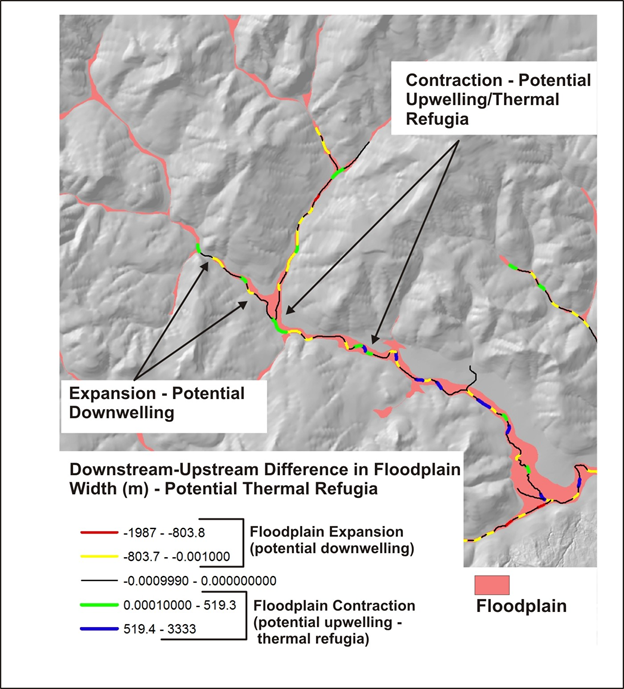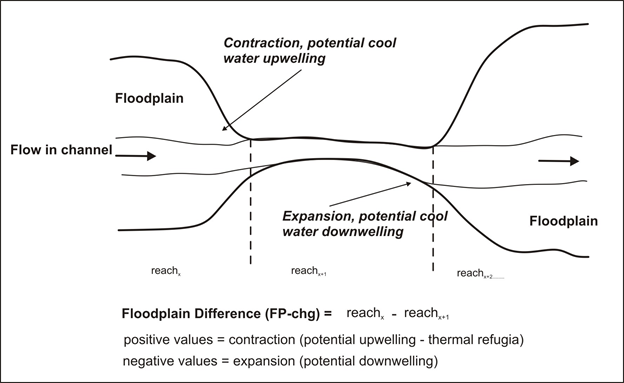
These findings highlight the importance of using multiple approaches to describe thermal heterogeneity in large impounded rivers and the need to incorporate these types of rivers in the understanding of thermal riverscapes because of their limited representation in the literature. We demonstrated that (1) lateral contributions from tributaries dominated thermal heterogeneity (2) thermal variability at confluences was approximately an order of magnitude greater than of the main stem (3) potential cold-water refuges were mostly found at confluences and (4) the probability of occurrence of cool areas and median water temperature were associated with channel geomorphology and distance from dam. We explained the median water temperature and probability of occurrence of cool-water areas using generalized additive models (GAMs) at reach and sub-catchment scales, and we evaluated potential cold-water refuge occurrence in relation to these patterns. To describe these patterns, we used thermal infrared (TIR) imagery, in situ thermographs, and high-resolution 3-D hydraulic mapping. We examined thermal heterogeneity across space and time and identified potential cold-water refuges for salmonids in a large impounded river in inland northwestern USA. This occurs by restricting or eliminating connectivity in longitudinal, lateral, vertical and temporal dimensions. But you may need to prepare your system before installing the netmap.Dam operations can affect mixing of the water column thereby influencing thermal heterogeneity spatially and temporally.
NETMAP VALLEY WIDTH INSTALL
configure & make & sudo make install workflow. You can build and install the netmap kernel module for linux by following the standard. However, the practice is the same for other distributions. The instructions given below are followed and tested on Ubuntu TLS 20.04, kernel version 5.4.0-74 and Debian 10.9, kernel version 4.19.0-16-amd64. Netmap installation on a standard Linux distribution is straightforward. It should be observed that for slow devices (such as 1 Gbit/s and slower NICs, or several 10 Gbit/s NICs whose hardware is unable to sustain line rate), emulated and native mode throughput will most likely be similar or even the same. Although performance is inferior to native netmap mode, it is significantly better than various raw socket types (bpf, PF PACKET, and so on). If netmap does not natively support your NICs, they may still be used in netmap mode through emulation. Netmap natively supports the following devices on FreeBSD: Netmap natively supports the following devices on Linux: Requirements for Installing Netmap on Linux However, if you want to run Zenarmor in Routed Mode (元 Mode, Reporting and Blocking available) on supported Linux Distributions (Ubuntu 18.04 LTS & 20.04 LTS, Centos 7, & 8, Debian 10 and AlmaLinux 1) you must install Netmap by yourself.Īlso, if you have a Surricata, you should install netmap for a better performance of your IPS system.
NETMAP VALLEY WIDTH SOFTWARE
Netmap is already included and enabled by default in recent FreeBSD (>= 10.x), OPNsense(r) and pfSense® software software releases. For FreeBSD and Linux, it is implemented as a single kernel module. Netmap is compatible with FreeBSD, Linux, and some versions of Windows. It is capable of handling tens of millions of packets per second, matching the speed of 10G and 40G ports even with small frames. Netmap provides extremely fast and efficient packet I/O in kernel, userspace, and virtual machine platforms. This allows us to have a peek at packets and take actions before they even reach their destinations. Netmap is a DPDK-like kernel interface that Zenarmor uses to deploy between your Ethernet Adapter and Linux/BSD Networking Stack. using/loading netmap kernel modules on your Linux machine.netmap installation instructions on Linux operating systems(Ubuntu, Debian, CentOS etc.).netmap supported drivers/hardware requirements for netmap on Linux.You find information about the following topics in this netmap quick start guide: Therefore, we provide you the netmap installation steps in this netmap starting tutorial. Installing netmap to Linux operating systems may a little tricky. If you are using a Linux-based firewall such as iptables, ipfw, firewalld, etc., you should set up netmap on your Linux system to get the benefit of all Zenarmor capabilities or even Suricata.

However, on Linux, netmap is not included by default.

Latest FreeBSD-based systems come with already installed netmap for you and are ready to be installed the Zenarmor. To enjoy all of the filtering functionalities of the Zenarmor, you must have the netmap framework installed on your system. Zenarmor (Sensei) uses the netmap framework to access raw Ethernet frames.


 0 kommentar(er)
0 kommentar(er)
